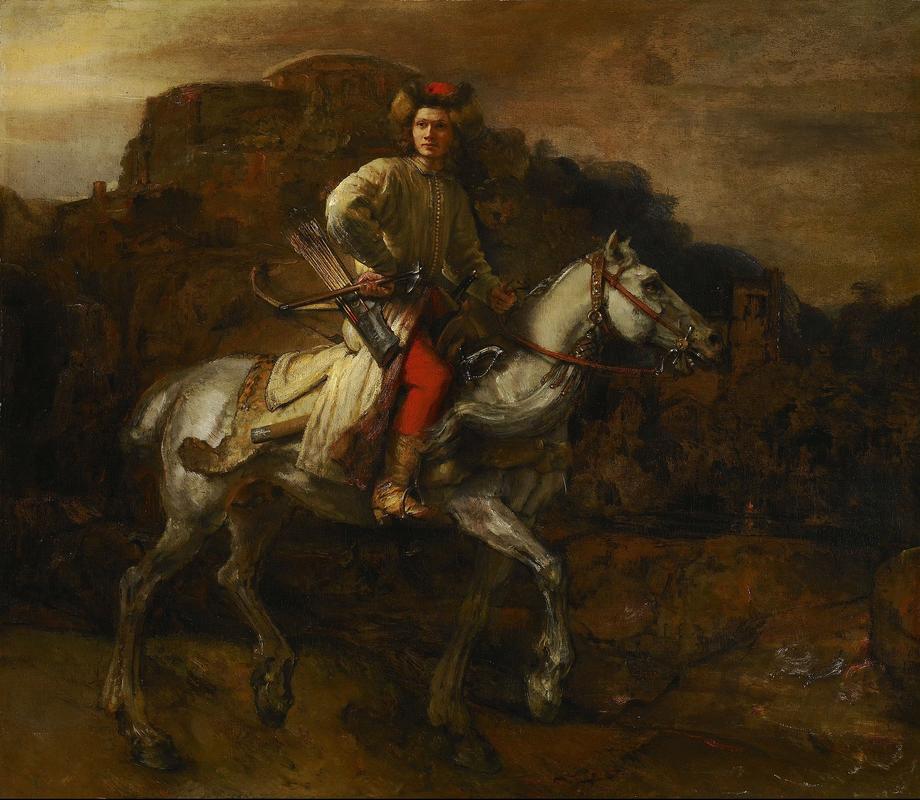More about The Polish Rider

Contributor
As a creator in any medium, you hope that your work resonates with people.
In a way, it’s a form of immortality. What you create will last far longer than you ever will. And if it’s good, it’ll have that an effect on people years after you’re gone. At its best, a fan base is a community of people coming together to appreciate something that they all love. But at its worst, fandom can be a toxic space that compromises the integrity of the work that brought all of these people together in the first place. Unfortunately, the latter was the case for Rembrandt and his painting The Polish Rider. On its surface, it’s hard to imagine how a painting featuring a handsome dude on a horse could cause so much commotion. But when you dig a little deeper, things start to make a little bit more sense.
Rembrandt, like so many other esteemed artists, has maintained a devoted following over the centuries. And when you’ve painted as many paintings with varying styles over as long a period of time as he did, there are gonna be people who study everything you ever did. In 1968, the Rembrandt Research Project was founded by a bunch of art scholars whose sole job was to figure out if a Rembrandt was really a Rembrandt. It’s understandable that there’d need to be something put in place to survey the field and make sure that these paintings—some of which would sell for mad dough—were the real deal. So the intent from the jump wasn’t malicious. But things started to get murky when it seemed like there was no rhyme or reason behind the “demotion” of a previously undisputed painting. At one point, the RRP dwindled the famed artist’s catalogue from 650 down to 250, mostly citing inconsistent patterns in the craft, or an abundance of signatures (It’s believed Rembrandt signed paintings that his pupils worked on to low-key steal the credit).
The Polish Rider was just one of hundreds of paintings to get the axe, but it might have been the most famous. It was the thing people loved about it most that made it so suspicious to the RRP. Rembrandt simply didn’t paint many paintings with dudes on horses. And when you couple that with the fact that it was created in his later years when he explored a freer expression, it was a standout amongst his work. Apparently this was grounds to demote the painting and attribute its ownership to one of Rembrandt’s most talented pupils, Willem Drost. The only problem is that not a lot is known about Drost, other than he was closely affiliated with Rembrandt.
You’d think that an artist trying out different styles and exploring a wide array of subject matter would be something to celebrate, but when you’ve got as much sauce as Rembrandt, it seems that the power of your work can tip in the favor of bad as much as it can good.
In 1993, the RRP promoted some of the previous demotions back to their original status, The Polish Rider being among them. You can attribute time and inconsistent records to a lot of the controversial decisions made about Rembrandt’s work. But when you look at it in relation to things happening today, it makes you stop to think that maybe people unrelated to the actual piece of art in question have too much influence. Is there any credence to what the RRP is rooted in? Sure. But at the end of the day, they teeter on a tightwire so thin that their decisions have huge ramifications on what the past looks like.
Sources
- Benfey, Christopher “Ryder in the Darkness” NYR Daily. April 19th, 2017. Accessed February 20th, 2019. https://www.nybooks.com/daily/2017/04/19/albert-pinkham-ryder-in-the-da…
- Cumming, Laura “The 10 Best Disputed Artworks” The Guardian. October 31st, 2014. Accessed. February 20th, 2019. https://www.theguardian.com/culture/2014/oct/31/the-10-best-disputed-ar…\
- Grosvenor, Bendor “How To Identify a Real Rembrandt?” Financial Times. October 10th, 2014. Accessed February 20th, 2019. https://www.ft.com/content/496bfa7a-4e06-11e4-adfe-00144feab7de
Featured Content
Here is what Wikipedia says about The Polish Rider
The Polish Rider is a seventeenth-century painting by Rembrandt, usually dated to the 1650s, of a young man traveling on horseback through a murky landscape, now in The Frick Collection in New York. When the painting was sold by Zdzisław Tarnowski to Henry Frick in 1910, there was consensus that the work was by the Dutch painter Rembrandt. This attribution has since been contested, though those who contest it remain in the minority.
There has also been debate over whether the painting was intended as a portrait of a particular person, living or historical, and if so of whom, or if not, what it was intended to represent. Both the quality of the painting and its slight air of mystery are commonly recognized, though parts of the background are very sketchily painted or unfinished.
Check out the full Wikipedia article about The Polish Rider












